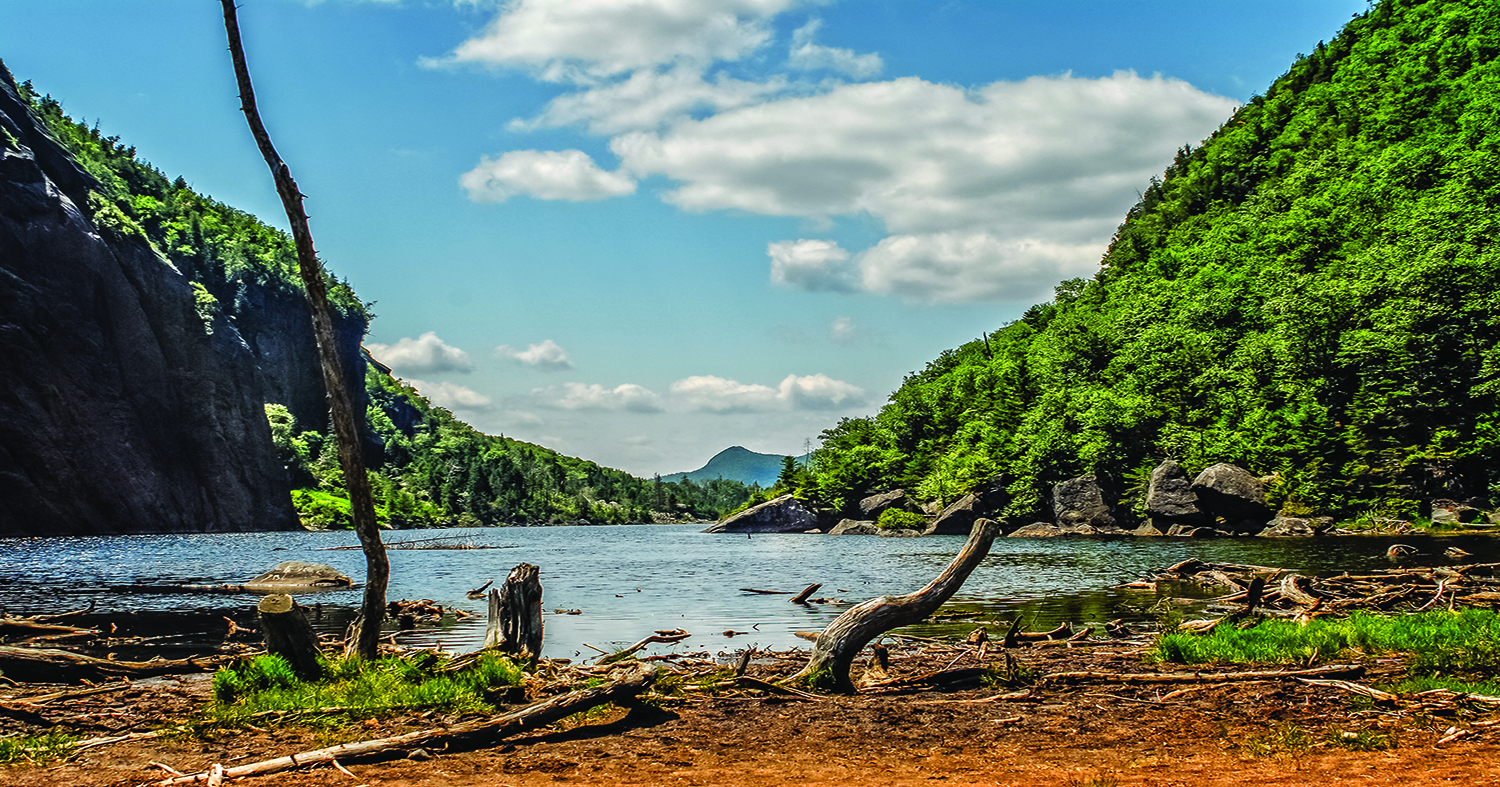The Adirondacks offer a variety of exceptional trails for hiking and outdoors recreation
The trailhead was busy — peak baggers crowded the path leading to Mount Marcy, New York state’s highest mountain. But after a mile and half, we reached Marcy Dam and our path diverged from that of the hikers seeking the 5,344-foot summit. They went left and we went right, and soon the trail was ours alone. We were in the Adirondacks seeking trails less traveled, wanting to enjoy the scenery of the High Peaks in solitude, and finding that the area offers an abundance of quiet routes seemingly undiscovered by the masses.
The Adirondacks region of northern New York spans more than six million acres of protected mountain peaks, pristine lakes and wild open spaces. The preserve was created in 1892, covering one-fifth of the state and featuring 12 distinct regions. When my wife and I decided to spend a week in the area, we zeroed in on the High Peaks area near Lake Placid. Each of the 46 “High Peaks” has an elevation over 4,000 feet and the region offers 2,000 miles of hiking trails. We chose to hike some of the less trafficked trails, seeking solitude as we traversed the woods.
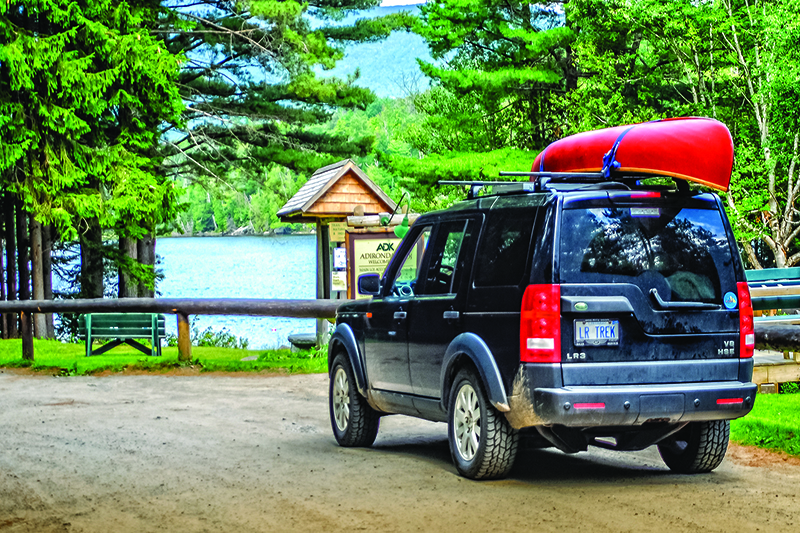
Leaving our home northeast of Toronto on a Monday morning, we gave my recently purchased LR3 its first extended run as we drove to our base camp at the Adirondack Mountain Club (ADK) Wilderness Campground at Heart Lake, just south of Lake Placid. The Land Rover comfortably held our kit for the week and soaked up the 300-plus miles with ease.
Heart Lake is the hub for many of the High Peaks trails, a fact made obvious by how quickly the parking areas filled up each morning. The campground is home to a small lake (for which it is named), perfect for a morning and evening paddle. For me, the original lure of the Adirondacks was canoeing, and dropping my 50-year-old Chestnut canoe into a lake to explore the shoreline drew me back to the park on more than one occasion. There is something special about waking up with loons calling at dawn and paddling through mist rising from the lake with the morning sun’s rays creating ethereal beams of light through the trees.

Our first hike was the 11-mile out-and-back to Avalanche Lake, starting from the trailhead where we encountered the Mount Marcy masses. After leaving the crowds at Marcy Dam, we soon came upon swaths of mangled trees, the dramatic after effects of avalanche slides in 1999 and 2011. Literally hundreds of dead trees were stacked at precarious angles close to the trail, an amazing sight. We hopped across boulders and through tight, sheer glacial walls as we approached our destination. Here at the top of the pass, the tree canopy and cliff walls provide deep shade, cooling the air temperature on the forest floor. Descending the final hill to the lake, we emerged on a shore tucked into a narrow gorge and flanked by sheer cliffs. Heading around the lake, we climbed the wooden ladders and scrambled over rocks before retracing our steps to the trailhead.
The next morning, we hiked with a pair of unusual companions. Before leaving home, we had arranged to visit the Adirondack Wildlife Refuge in Wilmington, New York. (www.adirondackwildlife.org) In addition to a number of raptors, foxes, lynx and bobcats, the refuge has three wolves. Each morning they offer a two-hour “wolf walk,” giving visitors a chance to see the wolves up close. We walked a short trail with two of the sanctuary wolves while Steve Hall, who runs the refuge, provided narration on the history of wolves and their interaction with humans. A recently acquired wolf pup, “Kiska,” was both entertaining and energetic — he was not still for even a moment. The nonprofit center receives very little funding so donations are welcome, allowing the refuge to continue to rehabilitate and release Adirondack wildlife. Recently the wolf enclosure was upgraded so the wolf walk is now a wolf gathering and, because of the enlarged size of the enclosure, visitors can more easily see the wolves eat and play. Be sure to bring your camera.
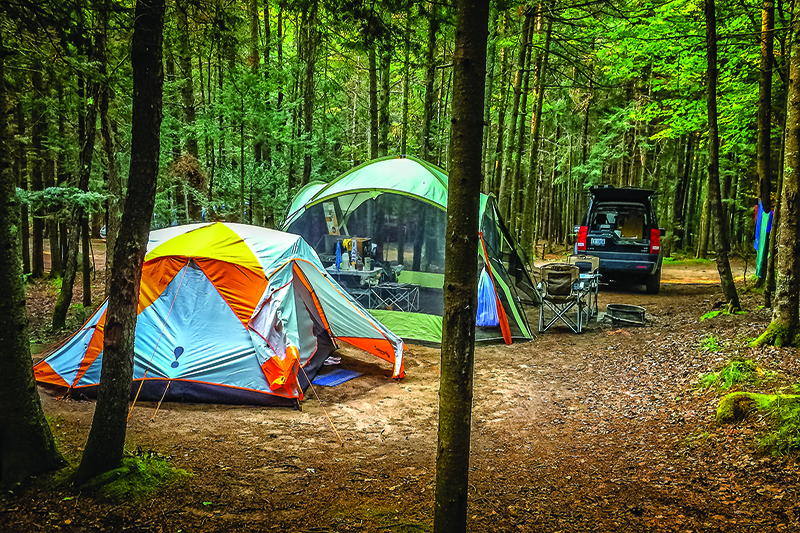
Whiteface Mountain was to be our afternoon destination but an overcast sky with low lying clouds meant there would be little to see at the summit. Instead, we headed to the Flume Trail System in the Wilmington Wild Forest where a network of interconnected trails provide about 10 miles of hiking and, except for a couple of restricted trails, mountain biking. We are drawn to any trail that features rapids, so we chose the River Trail along the Ausable River, making frequent stops to slip down through the trees and observe the rapids before the trail opened up and we jumped from rock to rock into the river’s flow. Looping back into the forest, we picked up the Lower Connector Trail to the Bluff Trail and back to the parking area, a total distance of about 2 1/2 miles. On the way we passed a beaver dam well over our heads, an impressive construction.
On our third day we trekked to Indian Pass/Summit Rock with an elevation of 2,880 feet, a 12-mile hike out and back. The trail was relatively smooth and flat to the detour down to Rocky Falls. But rain the previous day had made everything wet and when we started to climb Indian Pass, the slippery rocks made scrambling difficult. Traversing boulders the size of small cars with bridging ladders, we were indeed getting a workout. As we reached the top of Summit Rock, we gazed across to the inspiring view of the 1,000-foot face of Wallface Mountain, one of the highest cliffs in the Northeast.
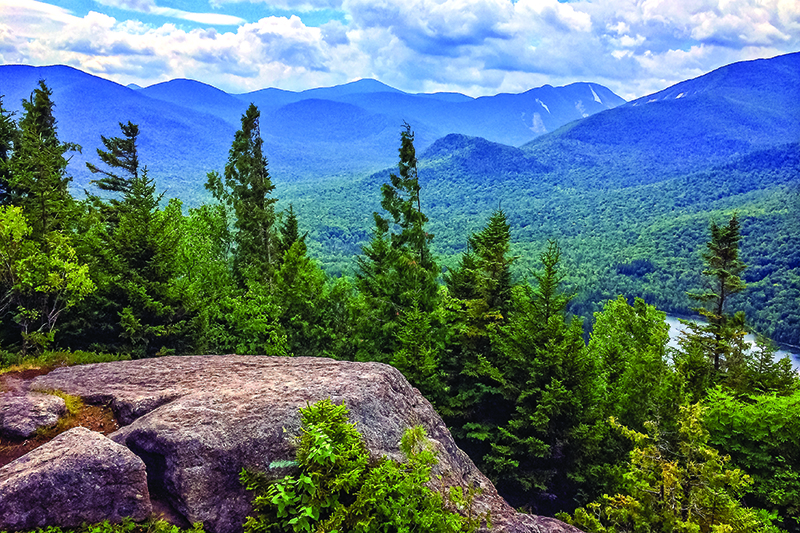
We ended our hiking adventure with the nicest trail of the week: Cathedral Rocks/Bear Run in Keene Valley. Even the drive from Lake Placid to the trailhead at Saint Huberts was amazing. As we wound down into the valley around long sweeping curves, the views were breathtaking. I was really feeling it for the road bikers we saw climbing those hills in preparation for the Ironman Races coming up that weekend.
Hiking up a paved road from the parking area, we entered Adirondack park land through a private golf course. A number of linked trails make up this hike. Our boots hit the relatively flat West River Trail as we paralleled the Ausable River, then we began to climb as we detoured to the Bear Run/Cathedral Rock trail. Bear Run had us scrambling up and through a tight fissure between two rock faces to reach the top. Here we discovered the famous “Hanging Tree,” a dead tree floating in the air, its roots 10 feet off the ground with no visible support. Making our way back down, we crossed a single log bridge and climbed steadily to Wedgebrook Cascades. We called a time out for lunch and dipped our feet in the cool rushing water, then picked up the East River Trail, crossing over rapids and returning to the trailhead. We saw no other hikers until the end of the hike.
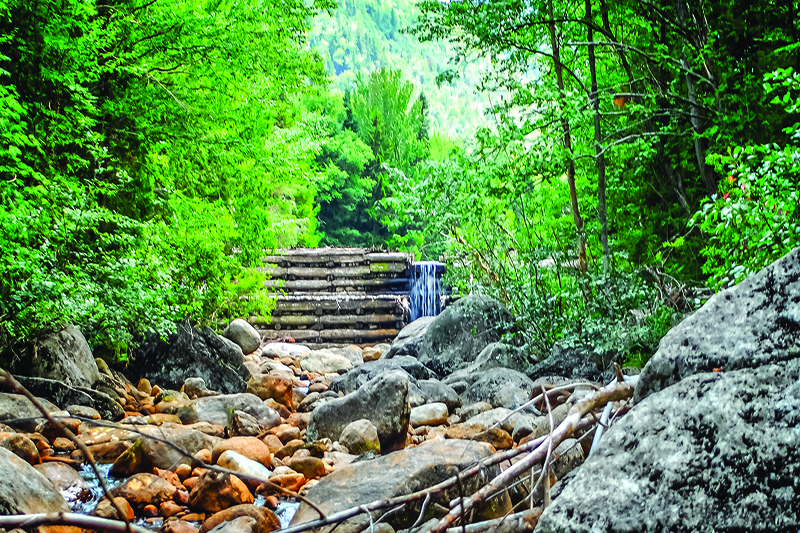
Back at the campground, we packed up, but then decided to hike one more trail before heading home. Mt. Joe is considered the shortest route to the best views in the Adirondacks and its trailhead is right at the campground. It’s a 710-foot climb to the summit; we took the easier but longer route to the top, climbing stairs cut out of the rock. A scramble over a large boulder had us on the summit. From the top we could see all the surrounding peaks, and views of the areas we had hiked earlier in the week. We descended a harder route, negotiating large rock after large rock, thankful for hiking poles — great for middle-aged knees!
Our Adirondacks trip was at an end. For us, it had been a good decision to avoid the very popular trails; it seems everyone wants to summit Mount Marcy, but most of the time we had the trails to ourselves. And, I’d had the opportunity to paddle the calm and peaceful Heart Lake each morning, harking back to previous trips to the park, exploring the shoreline and observing the wildlife.

Returning to Canada, we had none of the questions you typically get at the border. As soon as the Customs Officer found out where we had been, she peppered us with questions about the trails, the campgrounds, etc. I guess she’ll soon be making a trip to the Adirondacks as well.
Planning your Adirondacks Hiking Trip
Best Time to Go:
There is no bad time to visit the Adirondacks. While fall offers spectacular views of trees in full color, snowshoeing and skiing to frozen waterfalls during the winter has its attraction as well. Spring and early summer will have you dealing with the usual bugs: mosquitoes, deer- and horse flies.
Information:
We did most of our research online. Numerous resources offer details on hiking, canoeing, and attractions. The website www.visitadirondacks.com allows you to explore all that is available in the park, broken down by each of the 12 regions. Clicking through to the Lake Placid region offers links to hikes ranging from 1-2 hours to 8-plus hours, each with another link to trail maps and highlight details. We made great use of “Adirondack Great Walks and Day Hikes,” a PDF download, as a starting point. While this provides an overview, the Adirondack Mountain Club, www.adk.org, has even more detailed maps, guidebooks and resources to help with planning. We purchased the “High Peaks Trails” guidebook by Tony Goodwin and David Thomas-Train along with the National Geographic Trails Illustrated Topo Maps for the areas we planned to visit. The maps and guidebooks use the same numbering system so if you find a trail you like on the map, you can get full details from the guidebook. The club has numerous local chapters throughout the park, so depending on the area to be explored, events and full details can be found on the website of each chapter.
Likely, the biggest challenge hikers will encounter is parking. Many of the trailheads fill up early and leaving your vehicle where it’s not allowed could mean it will be gone when you return.
Gear to Bring:
While this comes down to how you plan to enjoy the park — car camping, single or multi-day hiking or canoe trekking — there are certain items we typically carry on a day hike. We each carry a pack but one is usually dedicated to my Nikon camera. We always carry plenty of water (4 liters), and if the trip is going to be longer than five hours, we bring our water filter too. A tripod, compass, maps, snacks and bear spray round out the second pack.
Other Spots in the Area Worth Visiting:
We treated ourselves to dinner one evening at the Lake Placid Brew Pub, sampling their fine menu and enjoying their craft beer. We can definitely recommend the Smoked Gouda & Roasted Red Pepper Soup, Pear & Maple Pizza, the Black Bean Burger and the Moose Island Ale. www.ubale.com
At the south end of the park, the Moose River Plains Wild Forest offers 116 free primitive roadside camp sites, all available on a first-come, first-served basis. From here there are multiple trails and lakes to explore. www.dec.ny.gov/lands/53596.html
And a visit to the park is not complete without a visit to the Adirondack Museum at Blue Mountain Lake. There are 24 galleries and historic buildings on the site, with daily programs and hands-on activities for kids. www.adkmuseum.org/
OutdoorX4 Magazine – Promoting responsible vehicle-based adventure travel and outdoors adventure


